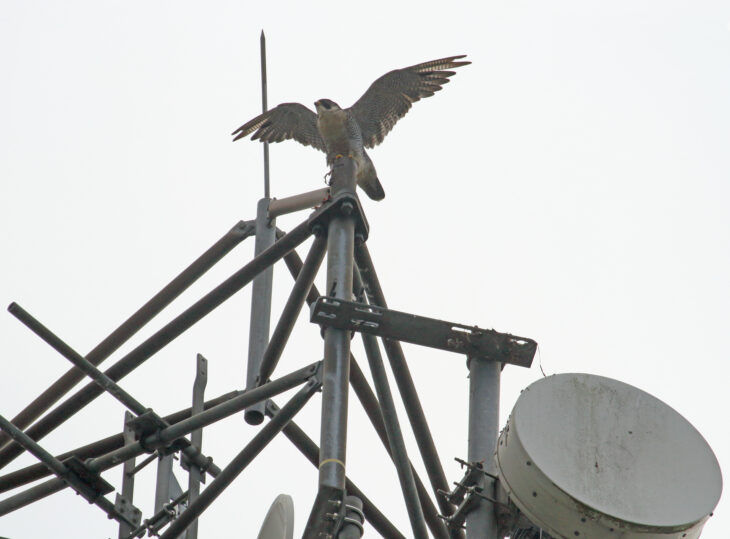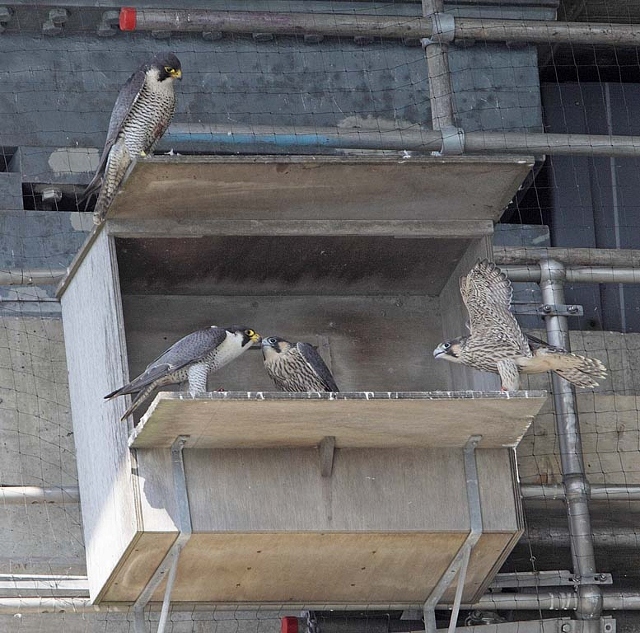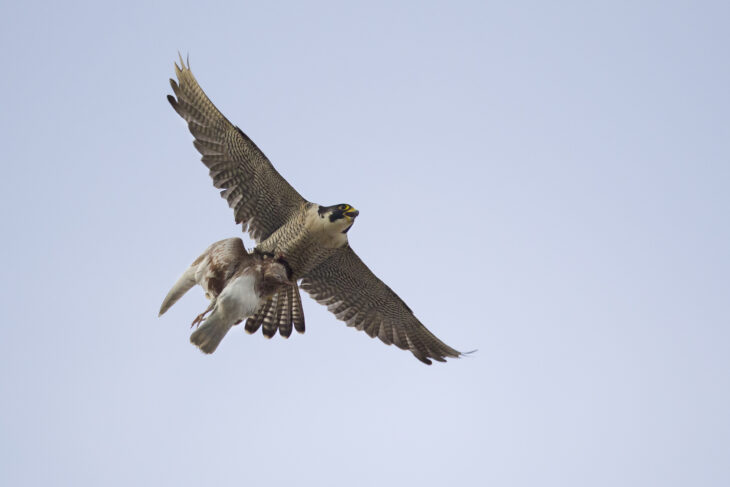Living Cities: Living with peregrines
The Trust’s Living Cities publication outlines practical actions that can be taken to embed nature into the urban environment.
In this guest blog, Charlie Everitt from the UK National Wildlife Crime Unit outlines some of the challenges of working alongside peregrine falcons and shows how encounters with inspirational wildlife can lift people’s spirits.
A murder mystery
At first I was puzzled. Why were all these light grey feathers strewn around the car park behind Randolphfield Police Station? Set in residential Stirling, only a stone’s throw from the city centre, I wondered if a fox had nailed an unsuspecting pigeon and the feathers had then scattered in the wind. But surely not in this quantity? I closed the car door and thought little more of the murder mystery unfolding before me.

Known as Randolphfield, the police station is the former headquarters of Central Scotland Police and still serves as an operational station serving the city centre of Stirling. Much of the infrastructure from pre-Police Scotland days remains, including the tall, thin, metal framework of the communications aerial that towers above the flat roof of the three storey building.
The aerial remains a vital piece of police equipment. It bounces signals to police officers’ radios as they attend the enormous variety of incidents on a daily basis and can literally save lives when officers request medical services or immediate support.
The offices of the UK National Wildlife Crime Unit (where I work) are within Randolphfield and I visit on a weekly basis, as much of my work takes me elsewhere around Scotland. A week later, I attended a meeting at the police station and the feathers were still present over the tarmac, lawns and paving.
Following the meeting’s conclusion, I returned to my car and heard a cry that I immediately recognised. A peregrine!
I looked up towards the top of the mast. Set against a cloudless, blue October sky and bathed in glorious sunlight that picked out the colours of its plumage, was a peregrine plucking away at a pigeon. A constant stream of feathers fell like snowflakes floating down to the car park. As a keen photographer I longed for my camera but, as that lay at home, I settled down to enjoy the spectacle with the murder mystery now solved!
Learning to live with peregrines
?Increasingly peregrine falcons are taking up residence within our towns and cities. With plenty of nesting ledges on high buildings, a steady supply of urban pigeons as a food source, and free from rural persecution, why wouldn’t the urban environment suit them?
I suspect the public welcomes their presence, just as officers based at Randolphfield constantly look towards the radio mast for the birds whenever entering or exiting the car park. A glimpse of nature can lift the spirits.
Living with peregrines, however, can cause issues. The detritus from pieces of carcass spread across the rooftop and grounds can be unsightly and perhaps even attracts unwelcome scavengers. I have been told that the peregrines have nested on Randolphfield’s mast in previous years which would have added a layer of complexity to any urgent repairs or modifications that may have been required to this vital piece of equipment. A licence to disturb the birds would need to be sought from Scottish Natural Heritage and the welfare of the falcons considered when risk-assessing work.
Security can also be an issue. On another autumn visit to Randolphfield, I parked my car and, as is now customary, looked up to the aerial. There were two peregrines at the top of the mast and, on a platform several feet below the pair, a third!

Perhaps this was a juvenile off-spring of the pair? I watched, momentarily mesmerised, and remembered that I had packed my camera. I had already taken a few photographs when two uniformed colleagues strode over to enquire about this person photographing the communication mast of the police station!
They were quite right to challenge me as we live in troubled times where security is a real concern but a quick flash of my warrant card led to an enjoyable chat with the officers about the birds!
Accommodating the peregrines might throw up some challenges but none are insurmountable and, for many, the benefits from the presence of peregrines far outweigh the pitfalls.
Peregrines are becoming part of urban life
Encouraging peregrines into the urban environment also has its challenges. Having previously helped to foster a peregrine nest – or scrape – on the outskirts of Edinburgh, attempts to entice their progeny into the city centre by installing a nest box on one of the higher spires was met with initial support that understandably fell away when the practical implications were considered.
Both old and tall buildings can require constant and long-planned maintenance so the presence of a protected bird may be considered detrimental to the practicalities in preserving historic or needy structures – especially when long-term scaffolding may need to be erected.
All land around the world now seems to be managed by man – even the wildest parts are managed to preserve them as such. As species require to adjust to man’s management, so we should adjust to accommodate those same species. Whatever structures peregrine falcons choose to adopt in our towns and cities, they should be welcomed and accommodated as they become part of the fabric of the urban environment.

Our attempts to entice peregrines into towns with nesting boxes may only be hastening the inevitable and the use of cameras to screen live footage of nesting young could attract huge interest from urban dwellers. It may also act as a natural balance to the growing populations of urban pigeons.
Police Scotland have lived happily with the peregrines at Randolphfield for several years and has never done anything to deter them from using the building. They have become a conversation piece for staff working in the building and, to me at least, offer a rare and privileged insight to these wonderful birds.
I await with interest to see if they nest on the mast this year. The site seems far too exposed to me but then I don’t think like a peregrine! Perhaps it may remain a feeding post to feast on a pigeon caught over the city? Time will tell, but I shall be watching the mast like a hawk (or perhaps that should be falcon!) throughout the spring and summer.
Charlie Everitt is a police officer seconded to the UK National Wildlife Crime Unit (NWCU) which is based within Randolphfield Police Station. He has worked in wildlife crime for 15 years – 5 while serving with Lothian & Borders Police in Edinburgh and 10 with the NWCU. He contributes towards the Partnership for Action against Wildlife Crime in Scotland and is a keen wildlife photographer.
Help protect Scotland’s wildlife
Our work to save Scotland’s wildlife is made possible thanks to the generosity of our members and supporters.
Join today from just £4 a month to help protect the species you love.
Preface
The Trust’s Living Cities publication outlines practical actions that can be taken to embed nature into the urban environment. In this guest blog, Charlie Everitt from the UK National Wildlife …
